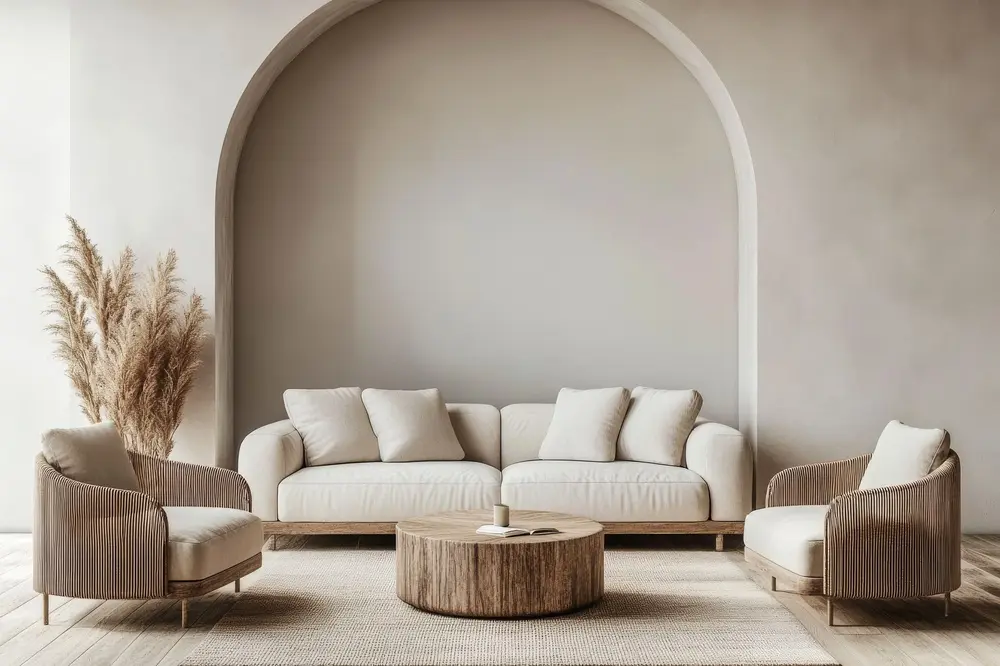Japandi Interior Design Unveiled: 7 Steps to Achieve the Look

Japandi interior design is the perfect fusion of two minimalist aesthetics: the warm, functional simplicity of Scandinavian design and the tranquil, nature-inspired elegance of Japanese design. This hybrid style combines the best of both worlds, emphasizing clean lines, natural materials, and a sense of balance that promotes harmony and comfort.
In recent years, Japandi has gained immense popularity among homeowners and designers seeking a calm, clutter-free environment that feels both modern and timeless. Whether you are drawn to the cozy hygge vibes of Nordic interiors or the serene wabi-sabi (embracing imperfection) philosophy of Japanese spaces, Japandi offers a unique way to bring these elements together in perfect harmony.
History of Japandi Interior Design
Japandi interior design is a fusion of two distinct yet complementary design styles: Japanese and Scandinavian. It fuses Japanese simplicity and elegance with Scandinavian warmth and functionality, blending ancient traditions with modern aesthetics.
Japanese design influences Japandi through wabi-sabi and traditional craftsmanship, while Scandinavian design, shaped by the cold Nordic climate, emphasizes comfort, warmth, and practicality with light woods and minimalist forms. This fusion of shared values has made Japandi a global trend that celebrates beauty, simplicity, and functionality.
Key Elements of Japandi
Japandi interior design blends Japanese wabi-sabi with Scandinavian lagom (balance and moderation), emphasizing minimalism, balance, and natural materials.It prioritizes decluttered, functional spaces while adding coziness through soft furnishings and muted color palettes.
Let’s explore the core principles that define this timeless and elegant design style.
1. Minimalistic Aesthetics

The cornerstone of Japandi interior design is none other than upholding the principle of “less is more”. Japandi opts for subtle, streamlined forms that highlight the natural beauty of materials and the overall structure of the space.
This minimalist approach encourages restraint and simplicity, making Japandi an ideal design for those seeking an uncluttered, peaceful retreat that values functionality as much as beauty.
2. Natural Materials and Cozy Textures

Drawing inspiration from both Japanese and Scandinavian traditions, Japandi emphasizes organic elements that age gracefully and offer a tactile experience. Wood plays a central role in Japandi design, with a mix of light Scandinavian woods like oak and ash, and darker Japanese woods like walnut and cedar. These materials add warmth and richness to the space while maintaining the clean, understated lines that characterize Japandi interiors.
Other organic materials such as bamboo, linen, stone, and rattan are also frequently incorporated to create a sense of harmony and balance that is both visually appealing and spiritually soothing.
3. Neutral and Muted Color Palette

A base of soft, neutral and understated colors such as whites, off-whites, beiges, grays, and taupes is used in Japandi styles. White and light gray are particularly favored for walls, ceilings, and larger furniture pieces, providing a blank and expansive canvas. These neutral tones also reflect natural light, contributing to the overall sense of airiness.
Muted colors such as shades of warm grays, earthy greens, soft blues, and dusky pinks are introduced through accent pieces such as textiles and wall decor. They add depth and interest without disrupting the calm aesthetic.
How to Achieve the Japandi Look
Achieving the Japandi aesthetic involves blending Japanese minimalism with Scandinavian warmth. This harmonious style embraces simplicity, intentionality, and a connection to nature, resulting in interiors that feel serene, purposeful, and effortlessly elegant.
1. Promote Balance and Moderation

Carefully arrange furniture, decor, and room layouts to create a sense of symmetry and balance, fostering a visually calming environment.
2. Select Minimalist Furniture

Look for simple, low-profile furniture made from natural materials such as wood, bamboo, or rattan. Integrate Scandinavian lightweight designs with the grounded presence of Japanese craftsmanship.
3. Combine Design and Functionality
Curate decorative pieces which are both beautiful and practical. Whether it is a handcrafted wooden sculpture, a stone bowl, or a woven rattan chair, they are not just decorative but often functional as well.
4. Choose a Neutral, Earthy Color Palette

Use muted tones like beige, taupe, white, and soft grays as the base.
Add subtle accents with earthy hues like sage green, dusty blue, or terracotta.
5. Use of Natural and Soft Artificial Lighting

Illuminate the space while enhancing the natural beauty of materials, complementing the neutral color palette, and creating a mood that feels calm, restful, and tranquil. Allow natural light to flood the space through large windows, open floor plans, and minimal window treatments, bringing warmth, lightness, and a connection to the outdoors.
Use warm, soft artificial lighting to enhance the cozy feel. Paper lanterns or Scandinavian pendant lights with simple designs work perfectly.
6. Add Japanese-Inspired Elements

Include shoji screens, tatami mats, or ceramic tea sets for a subtle Japanese influence.
Embrace wabi-sabi by showcasing imperfect, handmade items.
7. Add Indoor Plants

Add a variety of indoor plants, such as bonsais, succulents, or large leafy plants to bring life and freshness to the space.
Benefits of Japandi Interior Design
Japandi interior design offers more than just visual appeal; its philosophy and practical approach to interiors provide several benefits that enhance both the functionality and atmosphere of a space.
It promotes calmness and serenity through uncluttered spaces, neutral tones, and natural materials, fostering a peaceful and mindful atmosphere.
This timeless and purposeful design makes it a classic choice for modern living. By combining these elements, you can create a home that embodies the serenity of Japandi design, blending the best of both worlds.
If you prefer a moody and sophisticated take on the conventional Japandi style, check out Dark Japandi style which incorporates deeper, richer colors and contrasts, creating a more dramatic yet equally serene atmosphere.


